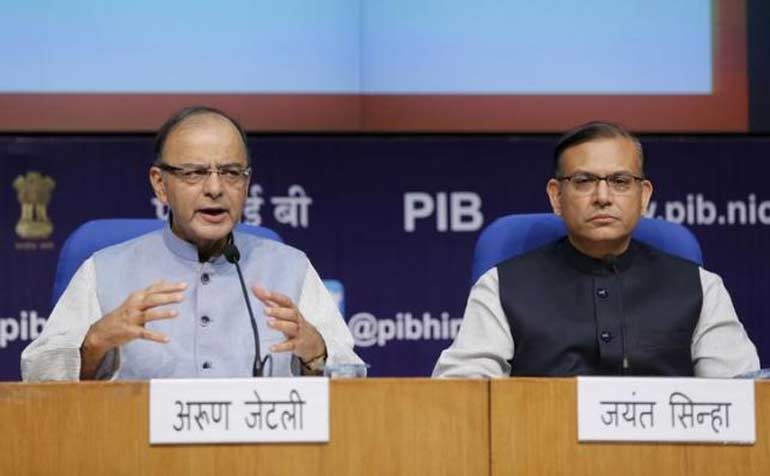Wednesday Feb 19, 2025
Wednesday Feb 19, 2025
Friday, 18 September 2015 00:00 - - {{hitsCtrl.values.hits}}
 India's Finance Minister Arun Jaitley (L) gestures as India's Minister of State for Finance Jayant Sinha watches during a news conference in New Delhi, India – REUTERS
India's Finance Minister Arun Jaitley (L) gestures as India's Minister of State for Finance Jayant Sinha watches during a news conference in New Delhi, India – REUTERS
Indian policymakers highlighted the resilience of Asia’s third-largest economy on Thursday, as world markets braced for what could be the first increase in US interest rates since before the global financial crisis.
Addressing a business conference, Finance Minister Arun Jaitley outlined the Government’s growth-friendly reform agenda and promised within days to resolve tax disputes with investors that have blighted India’s image as a place to do business.
“In a situation where there is turmoil almost by the day as far as global markets are concerned, we are trying to make the fundamentals of our own economy sound,” Jaitley said in a keynote address.
“Once we are able to walk on this growth track I am quite certain the architecture for growth in India will be settled, strong and deep.”
Indian financial markets swooned two years ago when Ben Bernanke, the then-chairman of the Federal Reserve, flagged the possibility that the US Central Bank’s aggressive policies of monetary easing would need to be wound down at some point.
The Fed was due to announce later on Thursday whether it would hike interest rates now, in a move that many in the financial community say would suck billions of dollars out of emerging markets.
Jaitley’s deputy, Jayant Sinha, said the Government was aiming for annual economic growth rates of 8-10% through a raft of supply-side measures that would increase India’s ability to grow and avoid a demand-driven boom and bust cycle.
Sinha said the Government plans to lift the cap on equity investments made by the main, $ 100 billion, State pension fund to 15% from 5%, in a bid to stabilise domestic equity markets by allowing greater investment by long-term funds.
The former McKinsey consultant and venture capitalist said the Government had ramped up public investment by 40% this year, as part of Prime Minister Narendra Modi’s drive to modernise roads and railways. The Government has been chafing for the Reserve Bank of India to cut interest rates to reduce the cost of borrowing and make it easier for businesses to invest so that the Government’s pump priming can spark a broader investment-led recovery.
Inflation at 3.7% is well below the RBI’s January 2016 target of 6%, prompting some analysts to predict another rate cut at the next policy review in late September.
Yet a top central banker signalled caution even though the RBI’s main policy rate, at 7.25%, is nearly double consumer price growth.
India requires sustained low inflation and a credible program for fiscal rectitude to lower the cost of capital, RBI deputy governor Urjit Patel told the same conference in New Delhi.
Patel predicted India’s current account deficit would be 1.5% of GDP this fiscal year, far from the precarious position in 2013 when the deficit brushed past 5%.
Discover Kapruka, the leading online shopping platform in Sri Lanka, where you can conveniently send Gifts and Flowers to your loved ones for any event including Valentine ’s Day. Explore a wide range of popular Shopping Categories on Kapruka, including Toys, Groceries, Electronics, Birthday Cakes, Fruits, Chocolates, Flower Bouquets, Clothing, Watches, Lingerie, Gift Sets and Jewellery. Also if you’re interested in selling with Kapruka, Partner Central by Kapruka is the best solution to start with. Moreover, through Kapruka Global Shop, you can also enjoy the convenience of purchasing products from renowned platforms like Amazon and eBay and have them delivered to Sri Lanka.
Discover Kapruka, the leading online shopping platform in Sri Lanka, where you can conveniently send Gifts and Flowers to your loved ones for any event including Valentine ’s Day. Explore a wide range of popular Shopping Categories on Kapruka, including Toys, Groceries, Electronics, Birthday Cakes, Fruits, Chocolates, Flower Bouquets, Clothing, Watches, Lingerie, Gift Sets and Jewellery. Also if you’re interested in selling with Kapruka, Partner Central by Kapruka is the best solution to start with. Moreover, through Kapruka Global Shop, you can also enjoy the convenience of purchasing products from renowned platforms like Amazon and eBay and have them delivered to Sri Lanka.